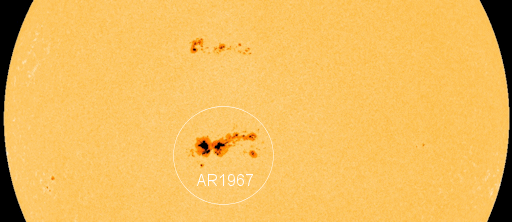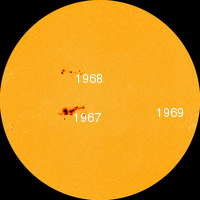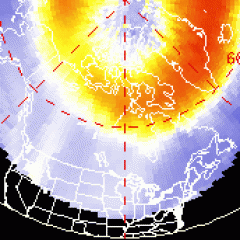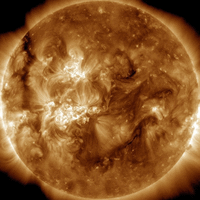~Space Weather Update~ Chance of Storms Today Continued M Class Flares WOOHOO [1]

CHANCE OF STORMS TODAY: NOAA forecasters estimate a 45% chance of polar geomagnetic storms on Feb. 2nd in response to a glancing blow from a CME. High-latitude sky watchers should be alert for auroras on Super Bowl Sunday. Aurora alerts: text [3], voice [4]
BIG SUNSPOTS FACE EARTH: A pair of large sunspots is directly facing Earth. The larger of the two, AR1967, has a 'delta-class' magnetic field that harbors energy for powerful solar flares. NASA's Solar Dynamics Observatory photographed the behemoth during the early hours of Feb. 2nd:
AR1967 is wider than the planet Jupiter and its primary dark cores are big enough to swallow Earth many times over. The scale [6] of the sunspot makes it an easy target for backyard solar telescopes. As shown in the gallery [7], astronomers around the world are snapping pictures.
The active region is already crackling with M-class solar flares. NOAA forecasters estimate a 15% chance of even stronger X-flares [8] during the next 24 hours. Any eruptions will be squarely Earth directed. Solar flare alerts: text [3], voice [4]

Solar wind
speed: 379.9 km/sec
density: 1.1 protons/cm3
explanation [9] | more data [10]
Updated: Today at 1756 UT
X-ray Solar Flares
6-hr max: M1 1406 UT Feb02
24-hr: M4 0931 UT Feb02
explanation [11] | more data [12]
Updated: Today at: 1800 UT
![]()
Daily Sun: 02 Feb 14
Sunspot AR1967 has a 'beta-gamma-delta' magnetic field that harbors energy for X-class [8] solar flares. Credit: SDO/HMI
![]()
Sunspot number: 147
What is the sunspot number? [14]
Updated 01 Feb 2014
Spotless Days
Current Stretch: 0 days
2014 total: 0 days (0%)
2013 total: 0 days (0%)
2012 total: 0 days (0%)
2011 total: 2 days (<1%)
2010 total: 51 days (14%)
2009 total: 260 days (71%)
Update 02 Feb 2014
The Radio Sun
10.7 cm flux: 166 sfu
explanation [15] | more data [16]
Updated 02 Feb 2014
![]()
Current Auroral Oval:
Switch to: Europe, USA, New Zealand, Antarctica
Credit: NOAA/POES
![]()
Planetary K-index
Now: Kp= 1 quiet
24-hr max: Kp= 3 quiet
explanation [18] | more data [19]
Interplanetary Mag. Field
Btotal: 4.8 nT
Bz: 2.9 nT south
explanation [20] | more data [21]
Updated: Today at 1756 UT
![]()
Coronal Holes: 02 Feb 14
There are no large coronal holes on the Earthside of the sun. Credit: SDO/AIA. ![]()




